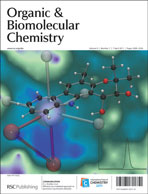Metallic triflates M(OTf)3 (M = Bi, Sc, Yb), immobilized in imidazolium ionic liquids [BMIM][BF4], [BMIM][PF6] and [BMIM][OTf] are efficient systems for one-pot reactions of propargylic alcohols 1,3-diphenyl-2-propyn-1-ol Ia, 1-methyl-3-phenyl-2-propyn-1-ol Ib, and 2-pentyn-1-ol Ic, with a wide range of arenes bearing activating substituents, under mild conditions. The [BMIM][PF6]/B(C6F5)3 and [BMIM][PF6]/TfOH systems were superior in propargylation with Ib and Ic, while reaction of 3-phenyl-2-propyn-1-ol Id with activated aromatics resulted in the formation of diaryl-propanones instead. Propargylation of anisole with Ib under M(OTf)3 catalysis is highly para selective, but with TfOH or B(C6F5)3 as catalyst the ortho isomer was also formed. Steric influence of the propargylic moiety on substrate selectivity is reflected in the lack of ortho propargylation for phenol and ethylbenzene by using propargylic alcohol Ia, and notable formation of the ortho isomer employing alcohol Ib. In the later case para selectivity could be increased by running the reaction at r. t. for 10 h. The Bi(OTf)3-catalyzed reaction of 1,3-dimethoxybenzene with Ia led to minor formation of dipropargylated derivative, along with the monopropargyl product. Propargylation of the less reactive arenes (mesitylene, ethylbenzene, toluene), using Sc(OTf)3 as catalyst, led increasingly to the formation of dipropargylic ethers and propargyl ketones, with no ring propargylation product with toluene. Concomitant formation of dipropargylic ether was also observed in Yb(OTf)3-catalyzed propargylation of β-naphthol, whereas propargylation of 2-nitro and 4-nitro-aniline led to N-propargylation. The recycling/reuse of the IL was demonstrated in representative cases with no appreciable decrease in the conversions over 3 cycles. It was also shown that recycled IL could be used to propargylate a different aromatic compound. The efficacy of IL/M(OTf)3 and IL/TfOH systems for cross-breeding two propargylic alcohols or a propargylic alcohol with a non-propargylic alcohol and/or self-coupling, to form a wide variety of functionalized ethers is also demonstrated.
![Graphical abstract: Electrophilic chemistry of propargylic alcohols in imidazolium ionic liquids: Propargylation of arenes and synthesis of propargylic ethers catalyzed by metallic triflates [Bi(OTf)3, Sc(OTf)3, Yb(OTf)3], TfOH, or B(C6F5)3](/en/Image/Get?imageInfo.ImageType=GA&imageInfo.ImageIdentifier.ManuscriptID=C0OB00872A&imageInfo.ImageIdentifier.Year=2011)

 Please wait while we load your content...
Please wait while we load your content...